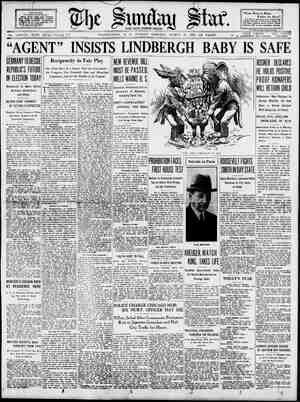Evening Star Newspaper, March 13, 1932, Page 76
You have reached the hourly page view limit. Unlock higher limit to our entire archive!
Subscribers enjoy higher page view limit, downloads, and exclusive features.
6 THE SUNDAY STAR, WASHINGTON, D. C., MARCH 13, 1932 nto Washington ntroduction of Gas Silas H. Hill, president, 1851-56. History of This Form of Public Service Includes John F. Callan, Ulysses Ward, president, 184849, George W. Riggs, president, 1849-51. % president, 1856-64. BY JOHN CLAGETT PROCTOR. or chamber at the top is six feet in their native city had few conveniences, and when, occasionally, cne had to walk a few miles in stormy weather, when the street cars did not run to his section of the city; or per- haps had to arouse the grocer late at night from his quiet slumber, just because some one had earlier failed to get the little oil can filled with kerosene, that daddy next morning might see to eat his breakfast. Things have not always been as comfartable fn Washington as we find them today, a fact the writer is old enough to offer in his per- sonal testimony, for, in 1887, when he moved into the Meridian section, where you now see all those fine embassies, the nearest street car was reached at its barn, then at Four- teenth street and Florida avenue, and there were no gas mains in that section for years later, and no Potomac water or sewerage. You could not press a button then and flash on the electric light; set the thermostat at night and awaken in the morning when It was freezing outside and find it nice and cozy within; turn on your gas light or cook meals on the gas stove; nor could you go to the phone and call a twenty-cent taxi or take a bus or street car at your door. Indeed, this is not the same city some of us knew half a century and more ago. We are living entirely under different conditions, in a new era, in a new and better Washington. CE was not manufactured here until 1881, Before that date, all ice for domestic pur- poses Was in, and if you desired to get a piece to soothe the fevered brow or cool Perhaps it takes time to convince the people of the value of some new invention—they seem rather to cling to the old ideas. As ths ce heard an elderly woman say, she used, or its scientific properties, are the writer will not discuss; however, Early Illumination of Capitol—Plants of the Local Company—Lighting the Avenue in Its Primitive Days. T Maine A Stuon, erected in 1851. being: Col. B. B. French, clerk of the House of Representatives; John F. Callan, Jacoo E F2EEd RUTCHETT was truly enthusiastic, and in his experiments considerably helped the matter along to a speedy and successful con- clusion, even if he did quit the field in favor parent success, as one might judge after read- ing the columns of the National Intelligencer. For instance, on January 15, 1847, we find the following item: “Solar Gas Light on Capitol Hill—One of the lamps around the Capitol appear quite dim—serving only to make ‘darkness visible.’ We sincerely hope that the time is not far distant when not only the Capitol, but the have the benefit of the solar gas light.' ber “most brilliantly,” and we find also that upon this date Congress appropriated $17,500, that he might light the Capitol grounds. Evidently the successful lighting of the Sen- ate Chamber had won & wvaluable friend for Mr. Crutchett, for soon afterward the Intel- ligencer tells us: “It is gratifying to observe the progress which has already been made by Mr. OCrutchett already great height, compared the Jevel of the most densly populated portions , six feet high, and well fitted with su- plate-giass reflectors, and surmounted with golden metal dome or ball. The iron braces fixtures are also in progress, and will be as materially to strengthen the dome . From all that we can judge, the will produce a magnificent effect, as this mode has been adopted and approved by seve eral churches in the larger cities. This ex- the illumination of large cities with few lights.” The lofty mast referred to was erected under the of Capt. Easby. AN earlier effort to light the dome of Capitol seems to have taken place on state, “that he had his full-length shadow distinctly reflected at the corner of Maryland buildings, urging the lighting of the Govern- ment buildings and grounds with gas, Prior to the introduction of gas at the Capitol, the building was lighted with oil lamps and can- dies. Up to 1825 there were only 10 oil lamps in the grounds; by 1830 there were 24 in In the forties the number of lights in and The present gas light company when char- tered, immediately took hold in earnest, and gas, for, by August 12 tions of $2,000 were made 100 lamps on the Avenue, be- and Fifteenth street. The was expended at once, the second In 1849 and 1850, and the third in 1849, smnet Jocation of the first gas plant of the Washington Gas Light Co. seems to be . il o SE i Rl iiREE i;i!i;f’ £7 g
